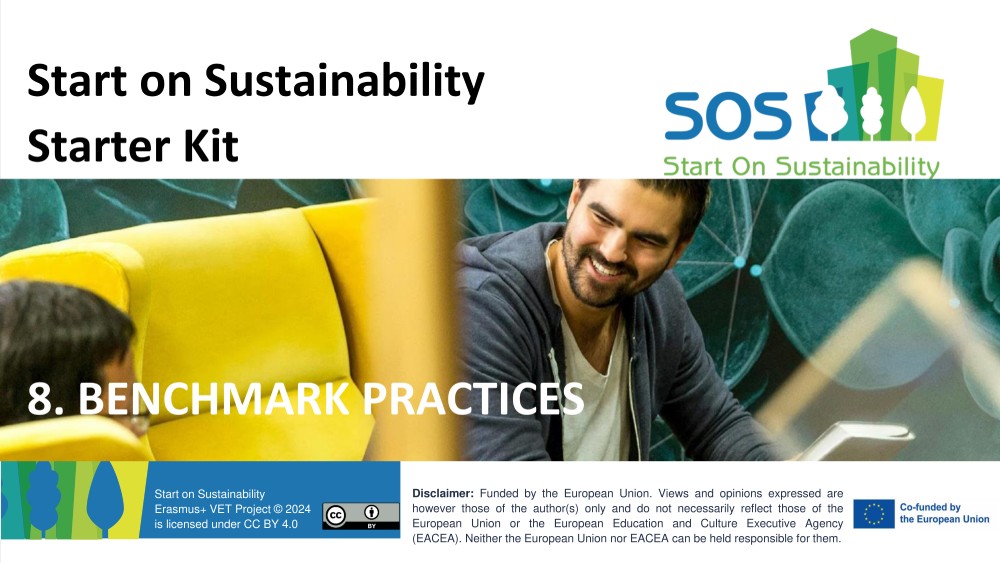
Unit 8 introduces ESG benchmarking and shows how small firms can compare their sustainability performance with peers and recognised standards. It explains key terms, good-practice principles, a simple process to run your own benchmarking exercise, and case studies you can learn from.
What this unit covers
- What is a benchmark and benchmarking? Clear definitions and why they matter for ESG.
- Principles of good benchmarking: transparency, rigour, stakeholder engagement, and impartiality.
- How to design and run a benchmark: scope, content, method, evaluation structure, and communication of results.
- Good practice guide: using recognised norms while keeping the approach practical for SMEs.
- Case studies: Lyft, Patagonia, and Danone — what worked and why.
- Assessment, key terms, and references to support learning.
Learning outcomes
By the end of Unit 8, learners will be able to:
- Define benchmark, benchmarking exercise, and benchmarking programme and explain their differences.
- Apply the four principles of good benchmarking in their own context.
- Plan a step-by-step benchmarking process that aligns with international guidance.
- Compare their practices against industry standards and peers and decide where to improve first.
Key ideas in plain terms
1) What is benchmarking for sustainability?
A benchmark is a reference point used to evaluate performance. Sustainability benchmarks help compare how companies or standards perform on ESG and where they fall short. Done well, benchmarking guides better decisions and avoids rewarding poor practice.
2) Core principles you must respect
- Transparency: share relevant information in an accessible way.
- Rigour: use a structured method that produces reliable results.
- Stakeholder engagement: invite input from those affected.
- Impartiality: manage conflicts of interest.
3) Common challenge
There is often little guidance on building credible benchmarks. Weak approaches risk rewarding underperformers and slowing real progress. Use a clear framework and recognised norms to avoid this.
Step-by-step: how to run a simple benchmarking exercise
- Set the purpose and audience
Who is this for (management, customers, investors) and what decisions will it inform? - Define the scope
What are you benchmarking — a product line, site, the whole company, or your supplier code? Choose the entities and indicators. - Align with norms
Note relevant standards or guides you will reference. Keep it right-sized for an SME. - Design the evaluation structure
Group criteria (e.g., governance, environment, social, data quality). Decide weights and scoring rules before you collect data. - Select the method
Document sources, evidence requirements, and how you will verify key claims. - Collect and assess data
Use a simple template. Record gaps and assumptions. - Report results clearly
Share a short summary: scores, strengths, gaps, and top three improvement actions. Tailor the detail to the audience. - Improve the process
After the first cycle, tighten criteria, cut noise, and reduce admin. Consider future programme status if you will repeat yearly.
Roles and definitions (quick reference)
- Entity: what you assess (a company, product, standard, or NGO).
- Convenor: the organisation that leads the benchmarking exercise and sets process rules.
- Benchmarking exercise: a one-off evaluation.
- Benchmarking programme: a recurring, structured series with stable rules and targets.
Case studies — what SMEs can learn
Lyft (mobility)
Set public climate goals, bought carbon credits, and invested in renewables and offsets. Clear messaging built brand value, though credits are not a full solution. Lesson: define bold targets and show tangible action while improving core operations.
Patagonia (outdoor apparel)
Promoted repair and reuse (“Don’t Buy This Jacket”), scaled free repairs, and saw sales grow while extending product life. Lesson: durability and service can drive both impact and growth.
Danone (food & beverage)
Moved towards circular packaging, backed waste-pickers, and invested in recycling infrastructure. Lesson: combine product targets (recyclability, recycled content) with system change (collection and worker protection).
Practical activities you can use tomorrow
- Mini-benchmark (60 minutes): pick five ESG criteria (e.g., energy, waste, labour, sourcing, data quality). Score yourself and two peer firms (public info). Identify your top three gaps.
- Evidence pack: assemble a small folder with policies, KPIs, and proof (audits, invoices, training logs) so you can answer buyer questionnaires fast.
- Improvement sprint: choose one criterion and run a 30-day fix (e.g., recycled content in packaging, basic supplier code, or better claim substantiation).
Measures that matter (keep it simple)
- Coverage: % of criteria with complete evidence.
- Score movement: points gained since last cycle.
- Time to respond: days needed to answer a buyer ESG request.
- Impact proxies: energy per unit, waste diverted, recycled content share.
Assessment (sample from the unit)
- What is the purpose of sustainability benchmarking? To compare performance and standards.
- Which is not a key principle: transparency, rigour, exclusivity, stakeholder engagement? Exclusivity.
- What is a benchmarking exercise? A one-time evaluation against a benchmark.
- How does benchmarking help? By comparing performance to guide improvements.
- Role of a convenor? Lead the development of the exercise or programme.
Key terms at a glance
Benchmark, benchmarking exercise, benchmarking programme, entity, convenor, stakeholder engagement, impartiality, ESG, best practice.
How to use Unit 8 in your business or classroom
- 90-minute workshop: run the mini-benchmark and agree the first improvement sprint.
- One-page scorecard: criteria, current score, target, owner, due date.
- Quarterly cycle: repeat the assessment and track score movement and outcomes.



